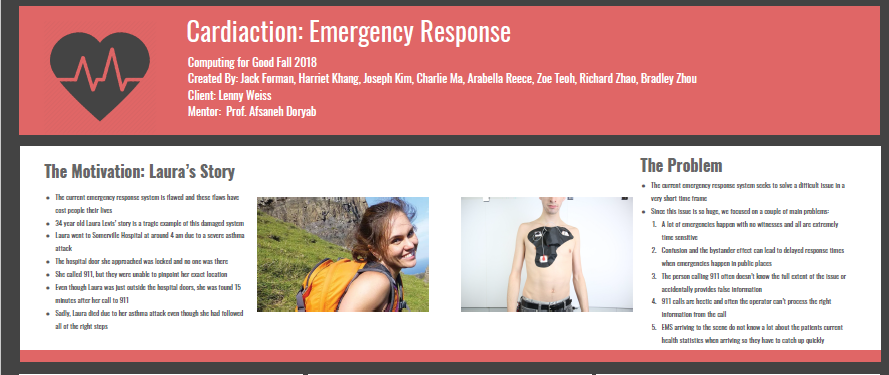
CardiAction: Emergency Response Capstone
911 response to emergency medical conditions involves complex logistics where lives are dependent on the capability of the systems that they encompass. Acute illnesses are time dependent, and minutes can make the difference between life and death. Modern 911 medical response systems have therefore been formulated around principles of rapid recognition and rapid response.
During the Fall 2018 Academic semester Computing For Good course, students utilized current examples of current work in the community being done by the courses partner, Lenny Weiss MD, Department of Emergency Medicine. Students evaluated challenges to detection and response of time-critical emergencies as a basis for proposed improvements to emergency response.
Body Sensors
Cardiac arrest occurs when the heart loses organized electrical rhythm and ceases to beat effectively. It is literally “sudden death” and is unpredictable, affecting all ages and genders. The most important initial treatment is early CPR and defibrillation by an AED. To facilitate this, our partners keep a registry of all public AED locations as well as have implemented a smartphone app called “PulsePoint” in our 911 system. The app sends an alert to volunteer layperson rescuers if a cardiac arrest is nearby. The layperson can see the location of the victim as well as the surrounding AEDs.
However, these alerts are limited to public locations and depend on someone generating a 911 call. Up to 2/3 of cardiac arrests are either not witnessed or in a non-public location. To address this problem, we developed a prototype wearable sensor that monitors real-time EKG rhythm data and could be connected to 911 alert systems or bystander notification systems, such as Pulsepoint. In this way, authorities and lay-rescuers could be notified in the event of a private or unwitnessed event.
Crowd Detection
Similar to individual medical emergencies, response to mass casualty events or criminal activity involves coordination between multiple law enforcement agencies and emergency medical services with the challenging task of detecting the primary problem, rescuing and treating those affected, and preventing secondary events.
We investigated a preventative strategy to detect threats and emergencies early, with hopes of allowing authorities to respond more quickly as well as warn citizens of potential danger. We proposed a crowd monitoring system which can identify and report anomalies in public behavior, an algorithmic approach to tracking crowds using computer vision techniques, as well as implemented an anomaly detection algorithm which is able to identify individuals moving in the wrong direction.
Natural Language Processing
In a modern communication environment, complex audio streams from telephone, cellular devices, and radios are constantly flowing. Analyzing these streams and assuring resilient and timely communication infrastructure is critical for emergency response. We developed a simple pipeline for processing recorded and live audio as a start for future work in natural language processing and machine learning of emergency communications.
Status: This early work will serve as the foundation of efforts to develop improved techniques of rapid emergency detection in our community. We will further test and refine these strategies and look to implement these first in simulated environments and eventually real-time emergency response systems.
Check out the YouTube video summarizing the work done by the students at Carnegie Mellon University and to learn more about work being done by Lenny Weiss, MD in our community. https://youtu.be/tGMXM5oFvB4.
Deliverable:

Faculty/Mentor
Afsaneh Doryab
Systems Scientist
Human-Computer Interaction Institute
Partner
Leonard Weiss, MD
Department of Emergency Medicine
University of Pittsburgh
